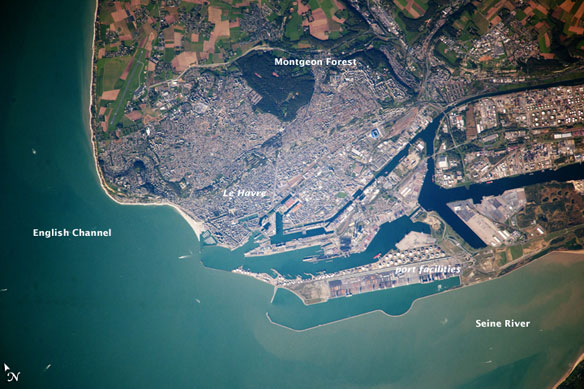
Impression Soleil levant, Claude Monet. Oil on canvas, 48 x 63 cm – Musée Marmottan Monet, Paris.
Dated 1872, its subject is the harbour of Le Havre in France, using very loose brush strokes that suggest rather than delineate it. Impression Soleil levant gave rise to the name of the Impressionist movement, where the atmospheric effect dominates and marginalizes the importance of the object’s shape.
Monet explained the title later: “Landscape is nothing but an impression, and an instantaneous one, hence this label that was given us, by the way because of me. I had sent a thing done in Le Havre, from my window, sun in the mist and a few masts of boats sticking up in the foreground. … They asked me for a title for the catalogue, it couldn’t really be taken for a view of Le Havre, and I said: ‘Put Impression.” Captions and photo source: Wikimedia
By William L. Stefanov, Jacobs / NASA,
The port city of Le Havre sits at the confluence of the Seine River and the English Channel along the northern coastline of France (Upper Normandy region).
It is the largest container port in France, and the second largest in total traffic after Marseille. The extensive port facilities, visible at image center, include numerous docks (large cargo ships are clearly visible), storage tanks for petroleum and other chemicals, and large industrial and warehouse facilities with white rooftops.
The port of Le Havre also serves seagoing pleasure cruise vessels. The southern edge of the port facility along the Seine includes a seawall-enclosed ship turning area (image lower center). North of the city, the Montgeon Forest includes 200 hectares of woodland and 30 hectares of meadows and lawns.

The urban area of Le Havre was largely destroyed during World War II. After the war, the city was rebuilt following the vision of architect Auguste Perret, who favored the use of reinforced and precast concrete in building structures. Much of the city built between 1945 and 1964 follows Perret’s plan in both form and materials—leading to the designation of Le Havre as a UNESCO World Heritage Site in 2005.








